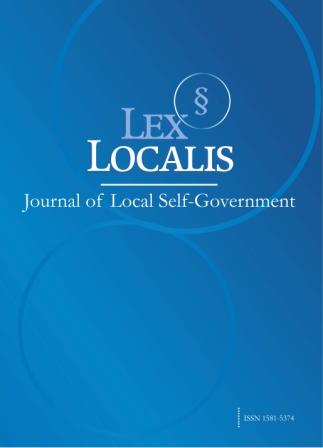Zastopanost žensk v okrajnih skupščinah: Študija o izvoljenih članicah kenijske okrajne skupščine
DOI:
https://doi.org/10.4335/20.4.1035-1055(2022)Ključne besede:
okrajne skupščine, dekoncentracija, vključevanje načela enakosti spolov, zastopanost, socialno ozadjePovzetek
Lokalne oblasti ponujajo priložnosti za različne skupine žensk v političnem udejstvovanju in njihovo vlogo lokalnih voditeljic pri zagotavljanju trajnostnega razvoja. V okviru vključevanja načela enakosti spolov je bilo v tej študiji proučeno, kako je ozadje žensk, kot je socialni status, njihov predhodni poklic, starost, izobrazba in vera, prispevalo k njihovemu dostopu do zakonodajnih vlog v kenijskih okrajnih skupščinah. Na podlagi podatkov o volitvah za leti 2013 in 2017 so rezultati pokazali, da je od petih spremenljivk versko ozadje žensk najmanj vplivalo na njihovo volilno in zakonodajno udeležbo. Čeprav obstajajo ustavne in institucionalne strukture za spodbujanje udeležbe žensk v volilni politiki, je še vedno treba krepiti ozaveščenost o zakonodajni vlogi in vlogi odločanja izvoljenih voditeljic. Ta študija prispeva k celovitemu pogledu na politično participacijo žensk in k narativnemu prehodu z nacionalne na lokalno moč odločanja, ki je kritična raven upravljanja.
Literatura
Arubayi, D. O. & Arubayi, D. O. (2016) Beyond the MDGs: inclusion, participation and the reality of gender development in Sub-Saharan Africa (SSA), International Journal of Development Research, 6(3), pp. 7228-7234.
Asiyati, L. C. (2016) Women in Local Government: A Potential Arena for Women’s Substantive Representation, CMI Brief, 15(13), available at: https://www.cmi.no/publications/file/5930-women-in-local-governmentpotential-malawi.pdf (September 7, 2022).
Khan, A. & Naqvi, S. (2020) Dilemmas of representation: Women in Pakistan’s assemblies, Asian Affairs, 51(2), pp. 286-306, https://doi.org/10.1080/03068374.2020.1748414.
Bari, F. (2005) Women’s Political Participation: Issues and Challenges, Expert Group Meeting (Bangkok: United Nations, Division for the Advancement of Women (DAW)).
Barriteau, E. (2003) Issues and Challenges of Caribbean Feminism, Agenda, Empowering Women for Gender Equality, 17(58), pp. 37-44.
Biegon, J. (ed.) (2016) Gender and Political Processes in Kenya (Nairobi: Strathmore University).
Cottrell, J. (2015) Women’s rights and the constitution (September 19, 2015) (Katiba Institute), available at: http://www.katibainstitute.org/womens-rights-and-theconstitution-by-jill-cottrell-ghai (October 17, 2021).
Eme, O. I. & Anyadike, N. O. (2014) Political Financing in Africa: A Comparative Study of Kenya and Nigeria: Proposal for Reform, Mediterranean Journal of Social Sciences, 4(5), pp. 22-34.
Fourth World Conference on Women (FWCW) Platform for Action (1995) Women in Power and Decision–Making, available at: www.un.org/womenwatch/daw/beijing/platform/decision/htm (May 13, 2022).
Hassan, M. (1999) Local Governance Study: Bangladesh (London: One World Action).
Hay, K. (2012) Engendering Policies and Programmes through Feminist Evaluation: Opportunities and Insights, Indian Journal of Gender Studies, 19(2), pp. 321-340.
Ilesanmi, O. O. (2018) Women’s Visibility in Decision Making Processes in Africa - Progress, Challenges, and Way Forward, Frontiers in Sociology, 3(38), pp. 1-7, https://doi.org/10.3389%2Ffsoc.2018.00038.
Independent Elections and Boundaries Commission, Kenya 2013 and 2017 Election results, available at: https://www.iebc.or.ke/election/?election-results (December 3, 2021).
Jayal, G. N (2005) From Representation to Participation: Women in Local Government (New Delhi: Nehru University).
Johnson, D., Kabachu, H. & Kayonga, S. V. (2003) Women in Ugandan Local Government: The Impact of Affirmative Action, Gender and Development, 11(3), pp. 8-19.
Kadaga, R. (2013) Women’s political leadership in East Africa with specific reference to Uganda (Commonwealth Secretariat).
Kamlongera, A. P. (2008) Malawian women’s participation in State politics: what are the constraints?, Gender and Development, 16(3), pp. 471- 480.
Nsubuga, J. K. & Olum, Y. (2009) Local Governance and Local Democracy in Uganda, Commonwealth Journal of Local Governance (2), pp. 26-43, available at: https:// www.researchgate.net/publication/267856004 (September 8, 2022).
Kameri-Mbote, P. (2016) The quest for equal gender representation in Kenya’s Parliament: Past and present challenges, In: Biegon, J. (ed.) Gender and Political Processes in Kenya (Nairobi: Strathmore University), pp. 39-66.
Kenyan Government (2010) Constitution of Kenya (Nairobi: Government Printer).
Khan, M.R. & Ara, F. (2006) Women, Participation and Empowerment in Local Government: The Bangladesh Union Parishad Perspective, Asian Affairs, 29(1), pp. 73–92.
Kurebwa, J. (2014) Rural women’s representation and participation in local governance in the Masvingo and Mashonaland Central Provinces of Zimbabwe, IOSR Journal of Humanities and Social Sciences, 19(12), pp. 125-132, https://doi.org/10.9790/0837-19124125132.
Mahapatro, M. (2014) Mainstreaming gender: Shift from advocacy to policy, Vision, 18(4), pp. 309-315.
Nazneen, S. & Tasneem, S. (2010) A Silver lining: Women in Reserved seats in Local Government in Bangladesh, IDS Bulletin, 41(5), pp. 35-42, https://doi.org/10.1111/j.1759-5436.2010.00164.x.
Opare, S. (2005) Engaging Women in Community Decision-making Processes in Rural Ghana: Problems and Prospects, Development in Practice 15(1), pp. 90–99.
Panday, P.K. (2008) Representation without Participation: Quotas for Women in Bangladesh, International Political Science Review, 29(4), pp. 489-512.
Quadir, S.R. (1994) Participation of Women at the Local Level Politics: Problems and Prospects, In: Chowdhury, N., Begum, H. A., Mahmuda, I., & Mahtab, N. (eds.) Women and Politics (Dhaka: Women for women), pp.1-14.
UN WOMEN (2018) Women’s Political Participation in Local Government, International Knowledge Network of Women in Politics (iKNOW POLITICS).
Vyas-Doorgapersad, S. (2017) Gender mainstreaming in local economic development processes: A South African perspective, International Journal of Economics and Finance Studies, 9(2), pp. 167-180.








